Peng Qi
TRUST-VL: An Explainable News Assistant for General Multimodal Misinformation Detection
Sep 04, 2025Abstract:Multimodal misinformation, encompassing textual, visual, and cross-modal distortions, poses an increasing societal threat that is amplified by generative AI. Existing methods typically focus on a single type of distortion and struggle to generalize to unseen scenarios. In this work, we observe that different distortion types share common reasoning capabilities while also requiring task-specific skills. We hypothesize that joint training across distortion types facilitates knowledge sharing and enhances the model's ability to generalize. To this end, we introduce TRUST-VL, a unified and explainable vision-language model for general multimodal misinformation detection. TRUST-VL incorporates a novel Question-Aware Visual Amplifier module, designed to extract task-specific visual features. To support training, we also construct TRUST-Instruct, a large-scale instruction dataset containing 198K samples featuring structured reasoning chains aligned with human fact-checking workflows. Extensive experiments on both in-domain and zero-shot benchmarks demonstrate that TRUST-VL achieves state-of-the-art performance, while also offering strong generalization and interpretability.
A Novel Coronary Artery Registration Method Based on Super-pixel Particle Swarm Optimization
May 30, 2025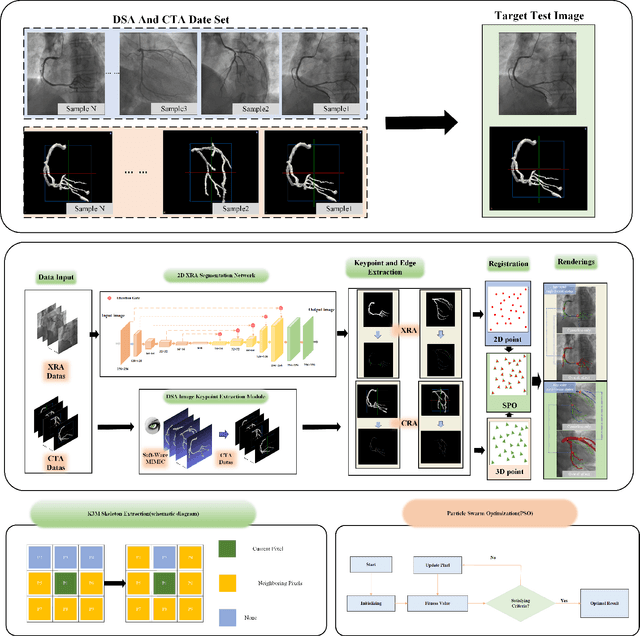
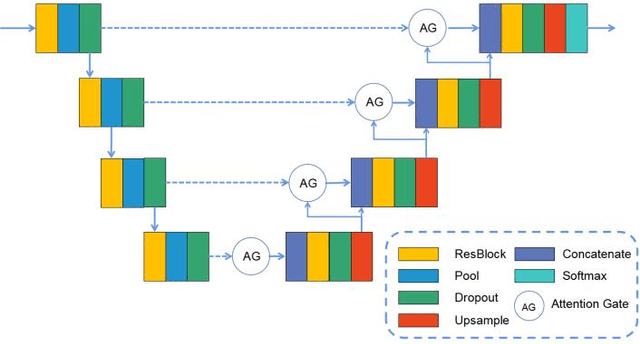
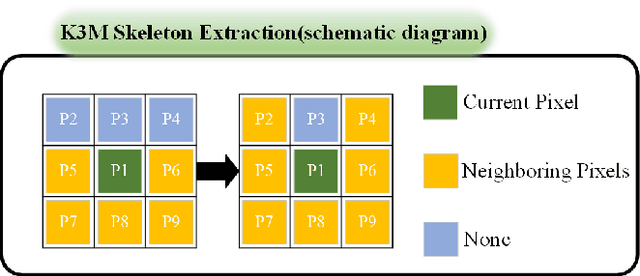
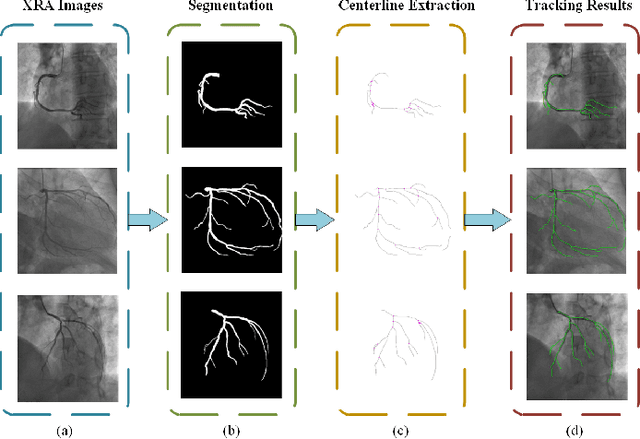
Abstract:Percutaneous Coronary Intervention (PCI) is a minimally invasive procedure that improves coronary blood flow and treats coronary artery disease. Although PCI typically requires 2D X-ray angiography (XRA) to guide catheter placement at real-time, computed tomography angiography (CTA) may substantially improve PCI by providing precise information of 3D vascular anatomy and status. To leverage real-time XRA and detailed 3D CTA anatomy for PCI, accurate multimodal image registration of XRA and CTA is required, to guide the procedure and avoid complications. This is a challenging process as it requires registration of images from different geometrical modalities (2D -> 3D and vice versa), with variations in contrast and noise levels. In this paper, we propose a novel multimodal coronary artery image registration method based on a swarm optimization algorithm, which effectively addresses challenges such as large deformations, low contrast, and noise across these imaging modalities. Our algorithm consists of two main modules: 1) preprocessing of XRA and CTA images separately, and 2) a registration module based on feature extraction using the Steger and Superpixel Particle Swarm Optimization algorithms. Our technique was evaluated on a pilot dataset of 28 pairs of XRA and CTA images from 10 patients who underwent PCI. The algorithm was compared with four state-of-the-art (SOTA) methods in terms of registration accuracy, robustness, and efficiency. Our method outperformed the selected SOTA baselines in all aspects. Experimental results demonstrate the significant effectiveness of our algorithm, surpassing the previous benchmarks and proposes a novel clinical approach that can potentially have merit for improving patient outcomes in coronary artery disease.
Advancing Embodied Intelligence in Robotic-Assisted Endovascular Procedures: A Systematic Review of AI Solutions
Apr 21, 2025Abstract:Endovascular procedures have revolutionized the treatment of vascular diseases thanks to minimally invasive solutions that significantly reduce patient recovery time and enhance clinical outcomes. However, the precision and dexterity required during these procedures poses considerable challenges for interventionists. Robotic systems have emerged offering transformative solutions, addressing issues such as operator fatigue, radiation exposure, and the inherent limitations of human precision. The integration of Embodied Intelligence (EI) into these systems signifies a paradigm shift, enabling robots to navigate complex vascular networks and adapt to dynamic physiological conditions. Data-driven approaches, advanced computer vision, medical image analysis, and machine learning techniques, are at the forefront of this evolution. These methods augment procedural intelligence by facilitating real-time vessel segmentation, device tracking, and anatomical landmark detection. Reinforcement learning and imitation learning further refine navigation strategies and replicate experts' techniques. This review systematically examines the integration of EI principles into robotic technologies, in relation to endovascular procedures. We discuss recent advancements in intelligent perception and data-driven control, and their practical applications in robot-assisted endovascular procedures. By critically evaluating current limitations and emerging opportunities, this review establishes a framework for future developments, emphasizing the potential for greater autonomy and improved clinical outcomes. Emerging trends and specific areas of research, such as federated learning for medical data sharing, explainable AI for clinical decision support, and advanced human-robot collaboration paradigms, are also explored, offering insights into the future direction of this rapidly evolving field.
Ultrasound-Guided Robotic Blood Drawing and In Vivo Studies on Submillimetre Vessels of Rats
Apr 04, 2025Abstract:Billions of vascular access procedures are performed annually worldwide, serving as a crucial first step in various clinical diagnostic and therapeutic procedures. For pediatric or elderly individuals, whose vessels are small in size (typically 2 to 3 mm in diameter for adults and less than 1 mm in children), vascular access can be highly challenging. This study presents an image-guided robotic system aimed at enhancing the accuracy of difficult vascular access procedures. The system integrates a 6-DoF robotic arm with a 3-DoF end-effector, ensuring precise navigation and needle insertion. Multi-modal imaging and sensing technologies have been utilized to endow the medical robot with precision and safety, while ultrasound imaging guidance is specifically evaluated in this study. To evaluate in vivo vascular access in submillimeter vessels, we conducted ultrasound-guided robotic blood drawing on the tail veins (with a diameter of 0.7 plus or minus 0.2 mm) of 40 rats. The results demonstrate that the system achieved a first-attempt success rate of 95 percent. The high first-attempt success rate in intravenous vascular access, even with small blood vessels, demonstrates the system's effectiveness in performing these procedures. This capability reduces the risk of failed attempts, minimizes patient discomfort, and enhances clinical efficiency.
Sim4EndoR: A Reinforcement Learning Centered Simulation Platform for Task Automation of Endovascular Robotics
Apr 04, 2025Abstract:Robotic-assisted percutaneous coronary intervention (PCI) holds considerable promise for elevating precision and safety in cardiovascular procedures. Nevertheless, current systems heavily depend on human operators, resulting in variability and the potential for human error. To tackle these challenges, Sim4EndoR, an innovative reinforcement learning (RL) based simulation environment, is first introduced to bolster task-level autonomy in PCI. This platform offers a comprehensive and risk-free environment for the development, evaluation, and refinement of potential autonomous systems, enhancing data collection efficiency and minimizing the need for costly hardware trials. A notable aspect of the groundbreaking Sim4EndoR is its reward function, which takes into account the anatomical constraints of the vascular environment, utilizing the geometric characteristics of vessels to steer the learning process. By seamlessly integrating advanced physical simulations with neural network-driven policy learning, Sim4EndoR fosters efficient sim-to-real translation, paving the way for safer, more consistent robotic interventions in clinical practice, ultimately improving patient outcomes.
Mitigating GenAI-powered Evidence Pollution for Out-of-Context Multimodal Misinformation Detection
Jan 24, 2025Abstract:While large generative artificial intelligence (GenAI) models have achieved significant success, they also raise growing concerns about online information security due to their potential misuse for generating deceptive content. Out-of-context (OOC) multimodal misinformation detection, which often retrieves Web evidence to identify the repurposing of images in false contexts, faces the issue of reasoning over GenAI-polluted evidence to derive accurate predictions. Existing works simulate GenAI-powered pollution at the claim level with stylistic rewriting to conceal linguistic cues, and ignore evidence-level pollution for such information-seeking applications. In this work, we investigate how polluted evidence affects the performance of existing OOC detectors, revealing a performance degradation of more than 9 percentage points. We propose two strategies, cross-modal evidence reranking and cross-modal claim-evidence reasoning, to address the challenges posed by polluted evidence. Extensive experiments on two benchmark datasets show that these strategies can effectively enhance the robustness of existing out-of-context detectors amidst polluted evidence.
Is Your LLM Secretly a World Model of the Internet? Model-Based Planning for Web Agents
Nov 10, 2024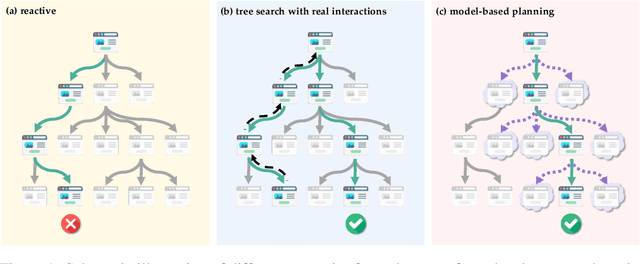
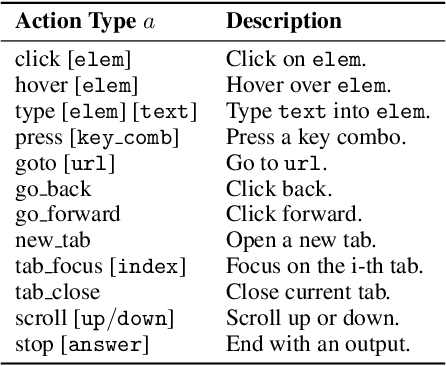
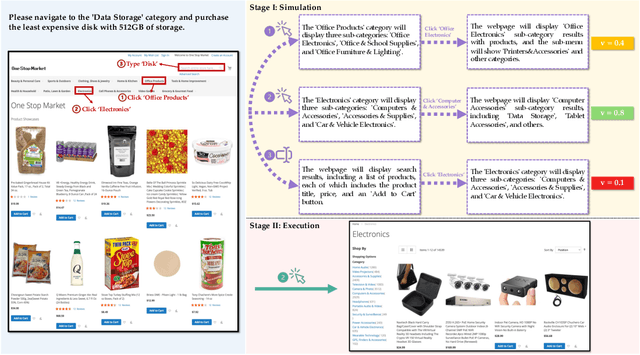
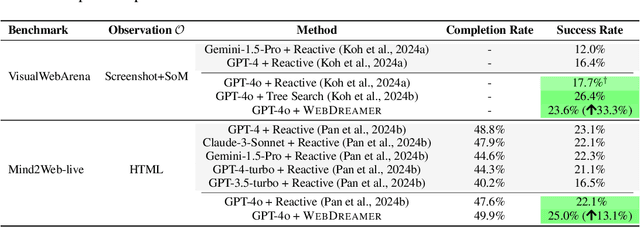
Abstract:Language agents have demonstrated promising capabilities in automating web-based tasks, though their current reactive approaches still underperform largely compared to humans. While incorporating advanced planning algorithms, particularly tree search methods, could enhance these agents' performance, implementing tree search directly on live websites poses significant safety risks and practical constraints due to irreversible actions such as confirming a purchase. In this paper, we introduce a novel paradigm that augments language agents with model-based planning, pioneering the innovative use of large language models (LLMs) as world models in complex web environments. Our method, WebDreamer, builds on the key insight that LLMs inherently encode comprehensive knowledge about website structures and functionalities. Specifically, WebDreamer uses LLMs to simulate outcomes for each candidate action (e.g., "what would happen if I click this button?") using natural language descriptions, and then evaluates these imagined outcomes to determine the optimal action at each step. Empirical results on two representative web agent benchmarks with online interaction -- VisualWebArena and Mind2Web-live -- demonstrate that WebDreamer achieves substantial improvements over reactive baselines. By establishing the viability of LLMs as world models in web environments, this work lays the groundwork for a paradigm shift in automated web interaction. More broadly, our findings open exciting new avenues for future research into 1) optimizing LLMs specifically for world modeling in complex, dynamic environments, and 2) model-based speculative planning for language agents.
Dancing in Chains: Reconciling Instruction Following and Faithfulness in Language Models
Jul 31, 2024Abstract:Modern language models (LMs) need to follow human instructions while being faithful; yet, they often fail to achieve both. Here, we provide concrete evidence of a trade-off between instruction following (i.e., follow open-ended instructions) and faithfulness (i.e., ground responses in given context) when training LMs with these objectives. For instance, fine-tuning LLaMA-7B on instruction following datasets renders it less faithful. Conversely, instruction-tuned Vicuna-7B shows degraded performance at following instructions when further optimized on tasks that require contextual grounding. One common remedy is multi-task learning (MTL) with data mixing, yet it remains far from achieving a synergic outcome. We propose a simple yet effective method that relies on Rejection Sampling for Continued Self-instruction Tuning (ReSet), which significantly outperforms vanilla MTL. Surprisingly, we find that less is more, as training ReSet with high-quality, yet substantially smaller data (three-fold less) yields superior results. Our findings offer a better understanding of objective discrepancies in alignment training of LMs.
FakingRecipe: Detecting Fake News on Short Video Platforms from the Perspective of Creative Process
Jul 23, 2024



Abstract:As short-form video-sharing platforms become a significant channel for news consumption, fake news in short videos has emerged as a serious threat in the online information ecosystem, making developing detection methods for this new scenario an urgent need. Compared with that in text and image formats, fake news on short video platforms contains rich but heterogeneous information in various modalities, posing a challenge to effective feature utilization. Unlike existing works mostly focusing on analyzing what is presented, we introduce a novel perspective that considers how it might be created. Through the lens of the creative process behind news video production, our empirical analysis uncovers the unique characteristics of fake news videos in material selection and editing. Based on the obtained insights, we design FakingRecipe, a creative process-aware model for detecting fake news short videos. It captures the fake news preferences in material selection from sentimental and semantic aspects and considers the traits of material editing from spatial and temporal aspects. To improve evaluation comprehensiveness, we first construct FakeTT, an English dataset for this task, and conduct experiments on both FakeTT and the existing Chinese FakeSV dataset. The results show FakingRecipe's superiority in detecting fake news on short video platforms.
RAG-QA Arena: Evaluating Domain Robustness for Long-form Retrieval Augmented Question Answering
Jul 19, 2024Abstract:Question answering based on retrieval augmented generation (RAG-QA) is an important research topic in NLP and has a wide range of real-world applications. However, most existing datasets for this task are either constructed using a single source corpus or consist of short extractive answers, which fall short of evaluating large language model (LLM) based RAG-QA systems on cross-domain generalization. To address these limitations, we create Long-form RobustQA (LFRQA), a new dataset comprising human-written long-form answers that integrate short extractive answers from multiple documents into a single, coherent narrative, covering 26K queries and large corpora across seven different domains. We further propose RAG-QA Arena by directly comparing model-generated answers against LFRQA's answers using LLMs as evaluators. We show via extensive experiments that RAG-QA Arena and human judgments on answer quality are highly correlated. Moreover, only 41.3% of the most competitive LLM's answers are preferred to LFRQA's answers, demonstrating RAG-QA Arena as a challenging evaluation platform for future research.
 Add to Chrome
Add to Chrome Add to Firefox
Add to Firefox Add to Edge
Add to Edge